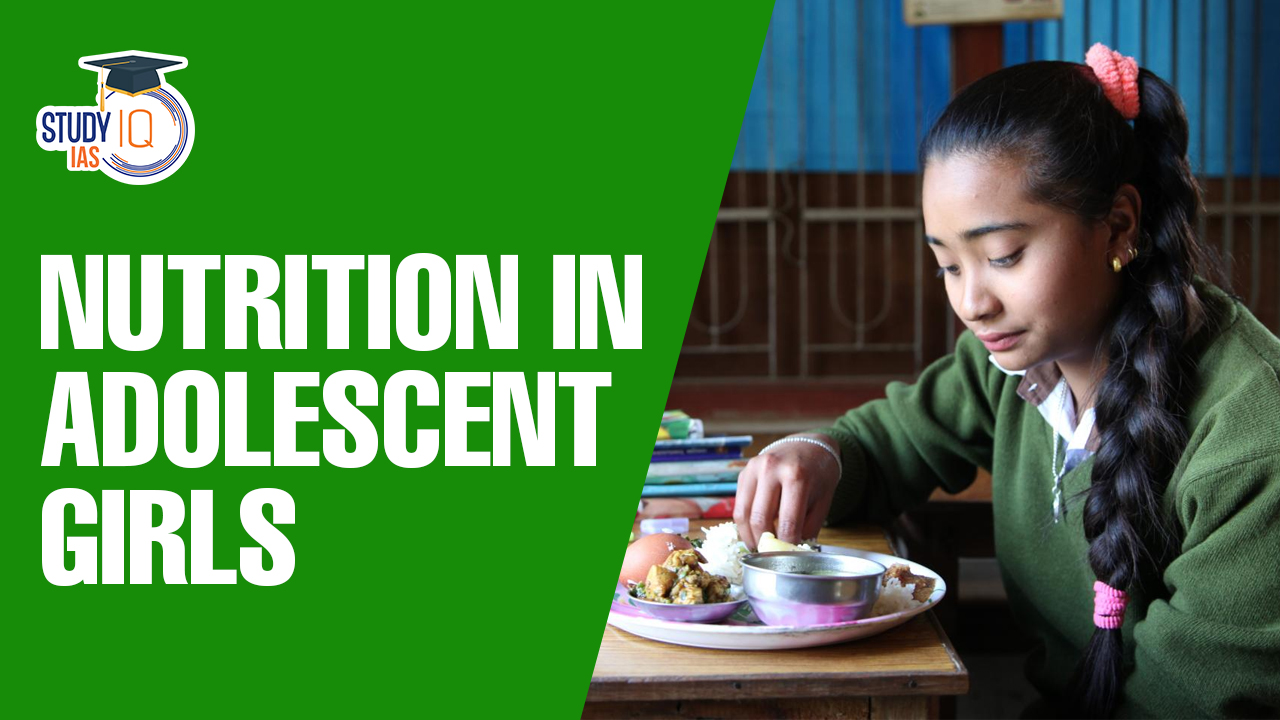Table of Contents
Context: Health and nutrition of India’s adolescent girls have to be prioritized to unlock the full potential of its future.
Adolescence
- WHO defines adolescence as the period of 10–19 years. This key decade in the life course has implications on adult health, socio-economic well-being of a country and even the health of the future children.
Present Status
- The prevalence of undernutrition and anaemia is high in adolescence girls due to the onset of menstruation.
- According to NFHS-4, over 41.9% of school-going girls are underweight. Similarly, NFHS-5 says that 59.1% of adolescent girls are anaemic.
- More girls suffer from shortness than boys; anaemia affects 40% of adolescent girls, compared to 18% of boys.
Need for ensuring nutrition during adolescence
- Compensates initial deficiencies: Nutrition during adolescence compensates for any nutrient deficiencies acquired during early developmental stages in the girl child.
- Increase labour participation: Healthy adolescence is a significant indicator of women’s labour force participation in the country in the long term, as better nutrition enhances a young girl’s prospect to participate in productive activities.
- It thus provides opportunity to India to add to its demographic dividend by investing in nutrition interventions in adolescent girls.
- Affects cognitive abilities: Poorly balanced and insufficient nutrition can lead to cognitive impairments that affect academic performance.
- This can lead to lower educational attainment, limiting opportunities for employment and economic self-sufficiency later in life.
- Pregnancy and health complications: Adolescent girls are at a higher risk of chronic diseases and pregnancy complications, thereby increasing health-care burden on both families and communities.
- Decline in social contributions: Less healthy and less educated girls are less likely to participate social activities, either through work, politics, or community involvement.
Bottlenecks in achieving results
- Cultural factors: In many cultures, girls are given secondary treatment compared to boys. Their nutritional needs are ignored.
- Familial poverty: In many regions of the world, poverty acts as a bottleneck in providing adequate nutrition. Inability to access nutritional food can affect health of adolescent girls.
- Environmental factors: Environmental factors cause droughts and flood that amplify existing poverty conditions. This can be a barrier in achieving nutritional standards.
- Disease burden: Many diseases spreading through food and water are responsible for causing illness, thereby lowering body nutrition.
Government initiatives to address malnutrition
- Anaemia Mukt Bharat (AMB): It is a national campaign launched by the Government of India in 2018 with the aim of reducing the prevalence of anaemia among women and children in India through a life cycle approach.
- The campaign aims to increase awareness about anaemia, promote the consumption of iron-rich foods, and provide iron and folic acid supplements to vulnerable groups, such as pregnant women and children.
- Weekly Iron and Folic Acid Supplementation (WIFS): This Programme is being implemented to meet the challenge of high prevalence and incidence of anaemia amongst adolescent girls and boys.
- The intervention under WIFS includes supervised weekly ingestion of Iron Folic Acid (IFA) tablets.
- To control worm infestation, biannual deworming with Albendazole is provided.
- Integrated Child Development Services Scheme (ICDS): Government implements Anganwadi Services, Pradhan Mantri Matru Vandana Yojana and a Scheme for Adolescent Girls under the Umbrella of ICDS as targeted interventions to address the problem of malnutrition in the country.
- POSHAN Abhiyaan: It is a flagship national nutrition mission to improve nutrition among children, pregnant women and lactating mothers.
- Mid-Day Meal Scheme: It is a school meal programme in India designed to better the nutritional standing of school-age children.
- POSHAN 2.0: “POSHAN 2.0 seeks to address the challenges of malnutrition in children, adolescent girls, pregnant women, and lactating mothers by developing, improving, and promoting practices that focus on health, wellness, and immunity”.
Way forward
- It is not only a moral obligation of the state but also an economic one to invest in girls’ nutrition, with potential returns in the form of sustainable economic growth of the nation.
- Life-cycle approach: The government intervention should not only centre around good nutrition but also adopt a life-cycle approach, ensuring each eligible girl is covered.
- This will help break the inter-generational cycle of poverty, as well-nourished girls are more likely to have healthy off-springs.
- Tweak in schemes: In order to obtain better outcomes, there is a need to make modifications to existing interventions. Effective convergence and collaborations among all the relevant departments is the need of the hour.
- Bringing Scheme for Adolescent Girls (SAG) within the umbrella of the Prime Minister’s Overarching Scheme for Holistic Nutrition programme (POSHAN) 2.0 will be a step in this regard.
- Stronger awareness and nutrition education programmes could be included under Rashtriya Kishor Swasthya Karyakram (RKSK).
- Effective training of health workers: Health workers could be trained for effective implementation and monitoring of various schemes.
- Evidence-based actions: Study has to be commissioned to recognise the conditions and also the reasons for low nutrition. Actions taken must be backed with strong evidence.


 Fiscal Slippage, Causes and Implications
Fiscal Slippage, Causes and Implications
 Serious Fraud Investigation Office (SFIO...
Serious Fraud Investigation Office (SFIO...
 Article 142 of Indian Constitution, Sign...
Article 142 of Indian Constitution, Sign...





















